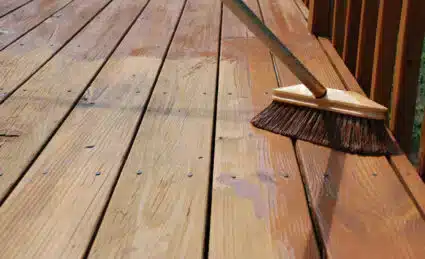Choosing between paint and stain affects how long your deck finish lasts. Both impact durability, appearance, and resistance to weather and wear like chipping. Since outdoor spaces are part of your living area, picking the right finish helps keep them strong and looking good. So, which lasts longer—paint or stain? Here’s what you need to know to decide.
Understanding Deck Paint
Deck paint does more than improve appearance—it protects wood from moisture, rot, and UV damage. Made with resins and pigments, it forms a durable, weather-resistant barrier. Options vary, from flexible formulas for shifting surfaces to tougher paints for high-traffic areas. Understanding these types helps you choose the right one for a long-lasting, low-maintenance deck.
Deck Paint Types
Paint Type
Pros
Cons
Oil
Most durable, fills cracks well
Not eco-friendly, slow drying, harder to clean
Latex
Most Affordable, Dries quickly, covers in a few coats
Can show brush strokes, Can cause grain to swell
Acrylic
Provides a thick durable, film, Drys Quickly, Mold and Mildew Resistant
More Expensive, can crack in high traffic areas
Examining Deck Stain
Deck stain protects wood while highlighting its natural look. Unlike paint, it soaks into the wood, enhancing grain and color. It guards against moisture, UV rays, and weather damage, helping your deck last longer. Stains come in transparent, semi-transparent, and solid options—each offering different levels of coverage and protection. Choosing the right type depends on your style and how much protection you need.
Deck Stain Types
Stain Type
Pros
Cons
Transparent
Never peels or flakes, best for new decks in great condition
Provides little UV protection, will need re-coating often
Semi-transparent
Provides a richer more uniform color, great for new decks or older ones with minimal damage
Can't hide major imperfections, Can't be applied over paint.
Solid
Wide variety of color options, Masks imperfections, Blocks UV Ray s
Hides grain of wood, will crack or peel
Durability Factors
When evaluating the durability factors of deck paint and stain, it is essential to scrutinize their resilience against diverse elements:

Resistance to Weather, UV Rays, and Foot Traffic:
- Deck paint forms a protective layer of protection, showcasing commendable resistance to harsh weather conditions, and shielding the wood from moisture infiltration and UV damage.
- Deck stain, by penetrating the wood, enhances its natural color and protects against weather elements, offering a unique approach to durability.
- Both finishes should be assessed for their ability to withstand foot traffic, a crucial factor in maintaining the deck’s integrity over time.
Addressing Issues like Cracking, Peeling, and Fading:
- Deck paint, by creating a surface barrier, tends to exhibit resilience against cracking and peeling, ensuring a more extended lifespan for the deck.
- Deck stains, while worn more gradually, may experience fading over time, necessitating periodic evaluation and maintenance.
Impact of Environmental Factors:
- Consideration of the local climate and environmental conditions is paramount, as these factors significantly influence the longevity of both deck paint and stain.
- Understanding how each finish responds to specific environmental challenges aids homeowners in making informed decisions based on their geographical location.
Understanding these durability factors becomes instrumental for homeowners seeking a deck finish that not only withstands external pressures but also maintains its integrity and allure in the face of various challenges.

Longevity in Real-world Scenarios
While paint and stain can both provide long-lasting protection for your deck, they have different performance characteristics and maintenance requirements. Case studies and testimonials from homeowners can offer valuable insights into how each finish holds up over time, taking into account factors such as exposure to the elements, foot traffic, and UV radiation. By examining these real-world examples, you can get a better sense of which finish is best suited to your specific needs and preferences.
For example, some homeowners have reported that paint can last for 5-7 years before needing to be reapplied, while others have found that stain can last for 7-10 years or more. However, it’s important to note that these estimates can vary greatly depending on the specific type of paint or stain used, as well as the amount of wear and tear the deck is subjected to.
Additionally, it’s important to consider the maintenance requirements of each finish. Paint typically requires more frequent cleaning and touch-ups than stain, as it can chip and peel over time. Stain, on the other hand, can be more forgiving and may require less maintenance, but it may also require more frequent reapplication to maintain its protective properties. Ultimately, the best finish for your deck will depend on your specific needs and preferences. I recommend consulting with a professional contractor or doing further research to determine which finish is best for your deck. Let me know if you have any other questions!

Maintenance Considerations
When it comes to maintaining the longevity of your deck finish, it’s crucial to consider the specific upkeep needs of both painted and stained decks. Understanding the maintenance requirements for each finish can help you plan for the future and ensure that your deck remains vibrant and protected for years to come.
Cleaning your deck is an essential part of maintaining its finish. You should clean your deck at least once a year, depending on the amount of use it gets.
Here are some tips for cleaning your deck:
- Use a mild detergent and water to clean your deck. Avoid using harsh chemicals or abrasive cleaners, as they can damage the finish.
- Use a soft-bristled brush or a broom to remove dirt and debris from the deck.
- For tough stains, you can use a deck cleaning product specifically designed for the type of finish on your deck.
As your deck ages, it can start to show signs of wear and tear, such as mold, mildew, and UV damage.
To increase the longevity of your deck finish:
- For mold and mildew, use a mildew-resistant cleaner to remove the growth and prevent it from returning.
- To avoid UV damage, make sure the finish you choose protects from the sun’s rays.
Here are some additional tips for maintaining your deck’s finish:
- Regularly inspect your deck for signs of wear and tear, and address any issues promptly.
- Avoid using harsh chemicals or abrasive cleaners, as they can damage the finish.
- Keep your deck dry and well-ventilated to prevent moisture buildup and mold growth.
- Consider using a deck cover or a tarp to protect your deck from the elements when it’s not in use.
Maintaining your deck’s finish is essential to ensure its longevity and beauty. Regular cleaning, sealing, and addressing common issues can help protect your deck from the elements and prevent damage. By following the tips and advice outlined in this blog post, you can keep your deck looking great for years to come.
Remember, a well-maintained deck not only adds value to your home but also provides a safe and enjoyable outdoor living space for you and your family. So, take the time to properly maintain your deck’s finish and enjoy the many benefits it has to offer.
If you have any further questions or concerns, or if you need additional assistance with maintaining your deck, don’t hesitate to contact a professional deck builder or contractor. They can provide you with personalized advice and guidance to ensure your deck remains in top condition for years to come.

So which finish is the winner?
Well, that depends, this exploration into the durability and longevity aspects of deck paint and stain has provided valuable insights for you to make informed decisions about your outdoor spaces. We’ve outlined the defining characteristics of both finishes, discussing how deck paint forms a protective layer while stain penetrates the wood, enhancing its natural beauty. The examination of durability factors, real-world scenarios, and maintenance considerations has shed light on the nuanced differences between the two options. While there isn’t a one-size-fits-all answer to whether paint or stain lasts longer, the presented information allows readers to weigh their priorities. In essence, the choice depends on factors such as weather exposure, desired aesthetics, and maintenance preferences, making stain a better choice for those who prioritize natural beauty.
In response to the main question of which deck finish lasts longer, the decision depends on individual circumstances. Those prioritizing a protective layer may prefer deck paint, while those desiring a natural look and easier maintenance may prefer stains. The key is matching the chosen finish with specific needs and preferences to ensure a lasting investment in both outdoor aesthetics and functionality.
So now it’s decision time, it is crucial to carefully consider your unique requirements. Whether aiming for a vibrantly painted deck or a subtly stained one, this choice significantly influences the overall appeal and longevity of the outdoor space. Lastly, for those undertaking deck renovation projects, Bargain Dumpster offers reliable roll-off dumpster services, ensuring a convenient and efficient solution for waste disposal needs. Choosing the right deck finish is undoubtedly a big decision, and coupled with proper waste management, homeowners can embark on a journey toward a resilient and visually pleasing outdoor environment.
Preparing Your Deck for Paint or Stain
Properly preparing your deck is crucial for ensuring a successful application of either paint or stain. The condition of the deck plays a significant role in the effectiveness and longevity of the finish. Before applying any coating, including a primer, it’s essential to assess the current state of the wood. Look for signs of wear, such as cracks, splinters, or areas of rot, as these issues can compromise the finish. Thorough cleaning is imperative; removing dirt, debris, and old finishes will help the new coat adhere better. Depending on the type of wood, you may also need to sand the surface to create a smooth texture that allows for optimal absorption of the finish. Taking these steps ensures that your chosen method, whether paint or stain, will perform effectively over time, providing the aesthetic and protective benefits you desire.
When choosing the right type of wood finish, consider the species of wood used in your deck. Different woods, such as cedar or pressure-treated pine, may require specific types of treatments, including a wood preservative, to enhance their natural properties. For instance, softer woods might benefit from a stain that penetrates deeply, while harder woods could be better suited to a durable paint that offers a robust protective layer. By aligning the finish with the wood type and addressing the condition of the deck, you set the stage for a long-lasting and beautiful outdoor space.
Comparing the Aesthetic Impact of Deck Paint vs. Stain
The aesthetic choices between deck paint and stain can dramatically influence the overall look and feel of your outdoor space. Deck paint offers a bold and vibrant finish that can transform your wood deck into a colorful feature of your home. Available in a wide range of colors, paint allows you to create a customized appearance that matches your personal style and complements the rest of your outdoor decor. However, the use of paint often means sacrificing the natural beauty of the wood, as it creates a solid barrier that obscures the grain and texture underneath.
In contrast, deck stain enhances the natural beauty of the wood, showcasing its grain and color variations. Stain penetrates the wood fibers, offering a more organic look that highlights the unique characteristics of the material. While the range of color options may be more limited compared to paint, stains come in various shades that can enhance or subtly alter the wood’s original hue, especially if it’s in good condition. This approach not only preserves the wood’s beauty but also provides a warm, inviting atmosphere to your outdoor area. Ultimately, the choice between paint and stain comes down to personal preference—whether you desire a striking, uniform color or wish to celebrate the natural elegance of the wood.
Color Options Analyzed
When it comes to color options, deck paint stands out with a vast array of choices, including a range of colors. Homeowners can select from solid colors, bright hues, and even textured finishes that can dramatically alter the deck’s appearance. This extensive range allows for creative expression, enabling you to coordinate your deck with your home’s exterior or create a unique outdoor aesthetic. Additionally, many paints come in finishes such as matte or gloss, providing further customization to match your style.
On the other hand, deck stain offers a more subdued palette that focuses on enhancing the wood’s natural tones with wood stain. Transparent and semi-transparent stains allow the wood grain to show through while adding a hint of color. This subtle approach is particularly appealing to those who wish to maintain the deck’s original character while providing some level of color enhancement. However, solid stains do exist and can provide more coverage similar to paint while still retaining some wood visibility.
When considering the aesthetic impact, it’s important to reflect on how the chosen color will interact with the surrounding environment. Lighter colors can create an airy feel, making the space feel larger, while darker shades can add depth and richness. Moreover, the finish type—whether glossy, satin, or matte—will also affect the deck’s overall appearance. Thus, weighing these factors carefully will guide you in making a color selection that not only meets your personal taste but also enhances your outdoor living space.
The Natural Beauty of Stain vs. Paint Coverage
The natural beauty of the wood is often a key consideration when choosing between stain and paint for your deck. Stain, particularly in its transparent and semi-transparent forms, allows the wood grain and texture to remain visible, celebrating the inherent qualities of the material. This approach not only enhances the wood’s natural beauty but also provides a warm, organic appearance that invites relaxation and enjoyment in outdoor spaces.
In contrast, paint creates a solid coverage that hides the wood’s grain, which can be both a benefit and a drawback depending on the desired outcome. While paint effectively conceals imperfections and provides a uniform look, it may detract from the natural aesthetic of the wood. This means that while paint can offer vibrant colors and a polished finish, it can also obscure the unique characteristics that make each piece of wood special.
Ultimately, the decision between stain and paint should reflect your personal preference and priorities regarding appearance and maintenance. If you prioritize showcasing the beauty of the wood, stain may be the ideal choice. However, if you seek a bold transformation with a resilient barrier against the elements, paint could be the way to go. By understanding the implications of each option, you can select the finish that aligns best with your vision for your deck.
